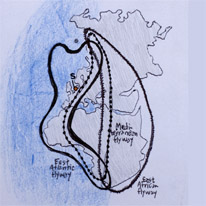Flyway
Stichting Waddenwerk, Summer 2009
About the project
Flyway is the result of a month long residency on the Dutch Island of Schiermonnikoog, supported by the organization Waddenwerk. Responding to the island's unique combination of traditional agricultural and gathering practices and diverse set of wild habitats, I built a work that addresses my interests in ecology and natural systems. Flyway was completed in August 2009, and will be on view through October 2009. It is installed in a large field on the west side of Eureca Farm, where it keeps company with cows, swallows and large dutch rabbits.
I began this project by exploring Schiermonnikoog and its varied habitats, from mudflats and brush covered dunes to pine forests and farmlands. Along the way, I gathered pieces of litter, branches, and driftwood, keeping a record of the locations where each item was collected. As my gathering progressed, I was also spending time in the Schiermonnikoog library, browsing the natural history section. On a shelf of bird books, I came across Vogels Van Schiermonnikoog, a book specific to the birds of Schiermonnikoog, and full of extensive descriptions of migration to and from the island. I came to understand how important Schiermonnikoog is as a resting place for migrating birds, and as a breeding and wintering ground. A one point I was struck by a diagram illustrating major bird migration routes throughout the world. Schiermonnikoog lies at the center of one of these routes, the East Atlantic Flyway. Birds like the Barn Swallow (hirundo rustica), which breed during the summer on Schiermonnikoog, fly along this route to their wintering grounds in South Africa. Others, like the Barnacle Goose (Branta Leucopsis) spend summers farther north and return to Schiermonnikoog via this route in the winter months:
Flyway is a sculptural representation of the shape of this migration route. It is made up of 20 unique sculptures, each built with materials collected in a different island bird habitat, from farmlands to isolated dunes to rich marshland. The sculptures, masses of twigs and litter perched on long poles, take the v-shape of flocking birds. They are arranged in a loop roughly 90 feet in length, reflecting the shape of the East Atlantic Flyway as it stretches between the Arctic and South Africa. The marker in the center of the loop indicates the location of Schiermonnikoog, and the v-forms face south, flexing and swaying in the constant wind.
The sculptures incorporate not only natural materials (sticks, twigs, grasses) but also partially degraded plastic bags, kite strings, candy wrappers and fishing nets. These human-made materials play an integral role in the structure of the sculptures, just as human intervention in the natural world plays an important and increasingly influential role in mysterious processes like bird migration.
About Ellie Irons
I am a New York-based artist making paintings, drawings and sculptures that explore the human/nature continuum. Before moving to New York City to study art, I lived in Northern California, where I grew up close to land, nature, and rural life. Prior to studying art, I studied ecology and sustainable development.
For some time, I truly thought I would be a scientist. When I was twenty one, I spent 6 weeks studying biodiversity in a remote part of Costa Rica. I was fascinated by my studies, but began to understand that rather than making a scientific report full of charts and graphs, what I really wanted was to express my passion for science and nature through art. Since that time, I have been turning this realization into a coherent approach to art making. In combining a naturalist's attention to detail and an artist's license to translate and recontextualize those details, I find fertile ground for artistic expression.


























































